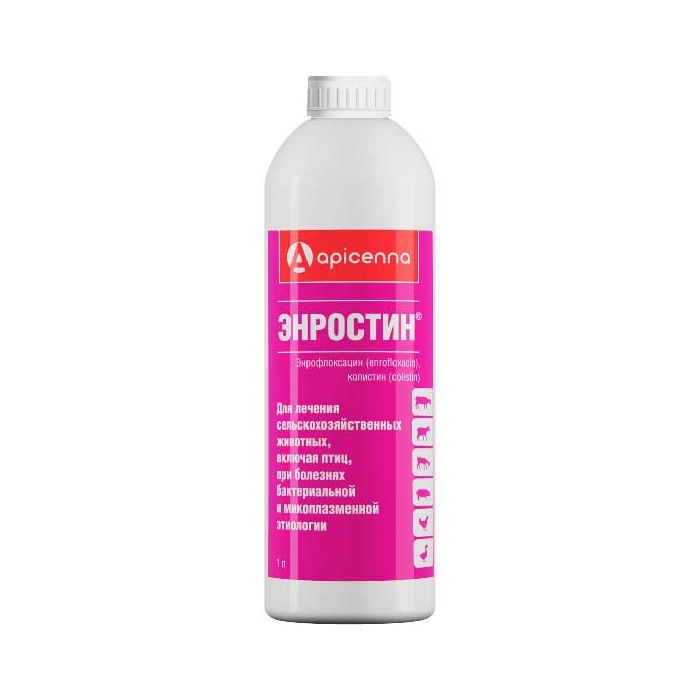Enrostin oral 1l
DESCRIPTION
Enrostin is a combination antibacterial drug. Dosage form: oral solution. In appearance, the drug is a light yellow to yellow liquid; during storage, a slight turbidity is allowed, which disappears after shaking.
COMPOSITION
Enrostin as active ingredients in 1 ml contains: enrofloxacin - 100 mg and colistin sulfate - 106 IU, as well as auxiliary substances: benzyl alcohol - 9 mg, sodium metabisulfite - 1 mg, lactic acid - 70 mg, syntanol - 10 mg and water distilled - up to 1 ml.
PHARMACOLOGICAL PROPERTIES
Enrostin belongs to the combined antibacterial drugs.
The combination of enrofloxacin and colistin sulfate, which are part of the drug, provides a wide range of its antimicrobial activity.
Enrofloxacin belongs to the compounds of the fluoroquinolone group, the mechanism of action of which is based on inhibition of the activity of the enzyme gyrase, which affects the replication of the DNA helix in the nucleus of a bacterial cell, which leads to suppression of the growth and development of gram-positive and gram-negative bacteria, including Escherichia coli, Haemophilus spp., Pasteurella spp., Salmonella spp., Staphylococcus spp., Streptococcus spp., Clostridium perfringens, Bordetella spp., Campylobacter spp., Corynebacterium pyogenes, Pseudomonas aeruginosa, and also Mycoplasma spp.
Colistin sulfate - a compound of the group of polypeptide antibiotics, disrupting the permeability of the bacterial cell wall by combining with ipoproteins, causes a change in intracellular metabolism and the death of gram-negative bacteria, including Escherichia coli, Pseudomonas aeruginosa, Klebsiella spp., Salmonella spp., Proteus spp.
After oral administration of the drug, enrofloxacin is well and quickly absorbed in the gastrointestinal tract and penetrates into most organs and tissues; excreted from the body unchanged and partly in the form of metabolites, mainly in the urine and in small quantities with feces; Colistin sulfate is practically not absorbed in the gastrointestinal tract, does not accumulate in organs and tissues, and is excreted from the body mainly unchanged with feces.
According to the degree of impact on the body, Enrostin belongs to moderately hazardous substances (hazard class 3 according to GOST 12.1.007-76), in recommended doses it is well tolerated by animals, does not have embryotoxic and teratogenic properties.
INDICATIONS
Enrostin is prescribed for therapeutic purposes in calves, lambs, pigs and poultry for respiratory and gastrointestinal diseases, colibacillosis, salmonellosis, streptococcosis, necrotic enteritis, hemophilia, mycoplasmosis, mixed and secondary infections, the causative agents of which are sensitive to colibacillosis.
APPLICATION
Enrostin is administered to animals orally once a day for 3 to 5 days, in the following doses:
Calves, lambs, pigs - 0.3 ml / kg of animal weight, drinking with water, for drinking at a dilution of 1: 1; in severe disease, the daily dose of the drug is increased to 0.5 ml / kg of animal weight;
Broilers, breeding poultry, replacement chickens, parent broilers and meat turkeys - 0.5 ml / l of water for drinking.
With salmonellosis, mixed infections, as well as with chronic forms of bird diseases, the course of treatment is extended to 7 days.
During the treatment period, the bird should only receive water containing the drug. The therapeutic solution is prepared daily in a volume calculated for the consumption of the bird during the day.
Avoid gaps in the introduction of the next dose of the drug, as this can lead to a decrease in effectiveness. If one dose is missed, the use of the drug is resumed in the same dose according to the same scheme.
CONTRAINDICATIONS
It is forbidden to use Enrostin in laying hens and replacement hens less than 2 weeks before the start of egg-laying, due to the accumulation of nrofloxacin in the eggs. It is not allowed to use Enrostin in adult ruminants with developed cicatricial digestion, piglets weighing less than 20 kg, animals with severe disorders of the development of cartilage tissue, severe kidney and / or liver diseases, with lesions of the nervous system, accompanied by seizures, pregnant and lactating sows.
OVERDOSE
In case of an overdose of the drug, the animal may experience a decrease in appetite, depression, vomiting, diarrhea.
SIDE EFFECTS
When using Enrostin in accordance with this instruction, side effects and complications are usually not observed.
With increased individual sensitivity to the components of the drug and the development of allergic reactions, the use of Enrostin is discontinued, and desensitizing therapy is performed.
Slaughter of birds for meat is allowed no earlier than 11 days; calves, lambs and pigs - no earlier than 14 days after the last use of the drug. The meat of animals that were forcedly killed before the expiration of the specified time limits can be used as feed for fur animals.
SPECIAL INSTRUCTIONS
Enrostin should not be used simultaneously with chloramphenicol, macrolides, tetracyclines, theophylline, polyester ionophores, non-steroidal anti-inflammatory drugs, drugs containing magnesium, aluminum and calcium cations, which, by binding to enrofloxacin, prevent its adsorption.
STORAGE
Store the drug in the manufacturer's closed packaging, in a dry place protected from direct sunlight, separately from food and feed, at a temperature of 5 В° C to 25 В° C. Shelf life, subject to storage conditions in a closed manufacturer's packaging - 2 years from the date of production, after opening - no more than 28 days. It is forbidden to use Enrostin after the expiration date.
Unused medicinal product is disposed of in accordance with legal requirements.
PACKING
Enrostin is produced packaged in polymer canisters with 1000 ml screw-on plastic lids.
Specifications
KolVUP
6
Manufacturer
APICENNA
Temperature regime
from +5 to +25
Teaser
combined antibacterial drug

